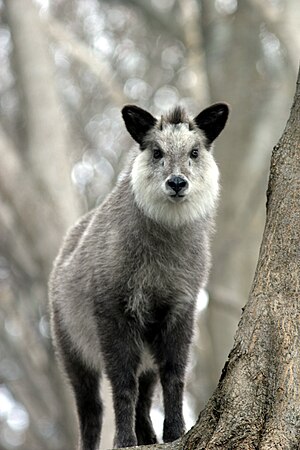Akita animals
From Akita Wiki
Domestic
- Akita dog.
- Helen Keller is thought to have introduced the Akita dog to the United States. Info
Birds
Akita is home to many of the large variety of birds native to Japan. While many head south or hide away in their homes during winter, come spring the chorus of sparrows, warblers, and wagtails add color to the crow calls. This is a list of the most commonly spotted/heard birds in the prefecture. For those who want to do a little more in-depth birding, the Merlin Bird ID app will let you identify birds by picture or description for free.
- 白鳥 (Hakucho). Swan. A variety of swans can be found in Akita's many lakes, ponds, and rivers. The Whooper Swan 大白鳥 (Oohakucho) winters in Akita, and can be found in groups on snow-covered rice paddies. Some JETs lovingly call these 'snow geese'. Their distinctive call is a sure sign that snow will come soon.
- 鴨 (Kamo). Duck. Ducks such as mallards live alongside the swans and geese.
- 鴎 (Kamome). Seagull. Seagulls and terns live in Akita's coastal cities.
- 真鶴 (Manadzuru). White-naped crane. Along with the hooded crane, these birds winter in Japan and Korea and are most commonly spotted from the months of October to April. If you see a similar sized white bird, it's most likely a Great or Intermediate Egret.
- 青鷺 (Aosagi). Gray Heron. Found in or flying around the rice paddies, along with the egrets.
- 鷺 (Sagi). Egret or Heron. Can be seen in rice paddies as well as riversides. They're particularly easy to find from fall until spring.
- 鳩 (Hato). Pigeon / Dove. Mostly found in the city, but sometimes they take a trip to the countryside.
- 雀 (Suzume). Sparrow. These birds are active year-round, but may be mostly hidden until the start of spring.
- 燕 (Tsubame). Barn Swallow. The return of these little brown and white birds are often seen as a sign of the start of spring.
- 鶴 (Tsuru). Crane.
- キツツキ (Kitsutsuki). Woodpecker. Woodpeckers are of course named for the way they find food: by using their beak to tap into trees and stumps. You might hear them tapping away before you spot one.
- 烏 (Karasu). Crow or Raven. The large to very large black birds you will see everywhere. If you hear a weird noise outside, it's probably a crow. Their calls range from throaty to the-sound-of-a-man-who-is-choking-to-death. Will see them all year, and they're especially striking flying over the snow in winter.
- 鶯 (Uguisu). Japanese Bush Warbler or Nightingale. You've probably heard their distinctive song before without realizing it. Their call is a traditional sign of the start of spring.
- 鶺鴒 (Sekirei). Wagtail. Most common are the Japanese Wagtail or the Black-Backed Wagtail. They usually build their nests near water.
- 雉子 (Kiji). Green Pheasant. A striking bird that you'll be able to recognize immediately. It is the national bird of Japan.
Additionally, there are a variety of hawks and other birds of prey which have a long history in the region, and many other varieties of songbirds. I highly recommend you get to know your flying neighbors!
Wildlife
- Kamoshika (カモシカ、羚羊). The Japanese Serow is a goatish looking antelope. It reminds me of the forest spirit in Princess Mononoke, although I am not sure of the connection. They have two horns, gray fur, and a mane.
- Ten. Marten or Japanese sable. These are larger than a cat and look similar to a weasel. They are a bright radiant brown, almost orange.
- Tsukinowa Guma (ツキノワグマ、月輪熊). Asiatic Black Bear. When there are bear sightings many warning signs will be put up. Walk, hike, and bicycle with a bell when in isolated areas.





